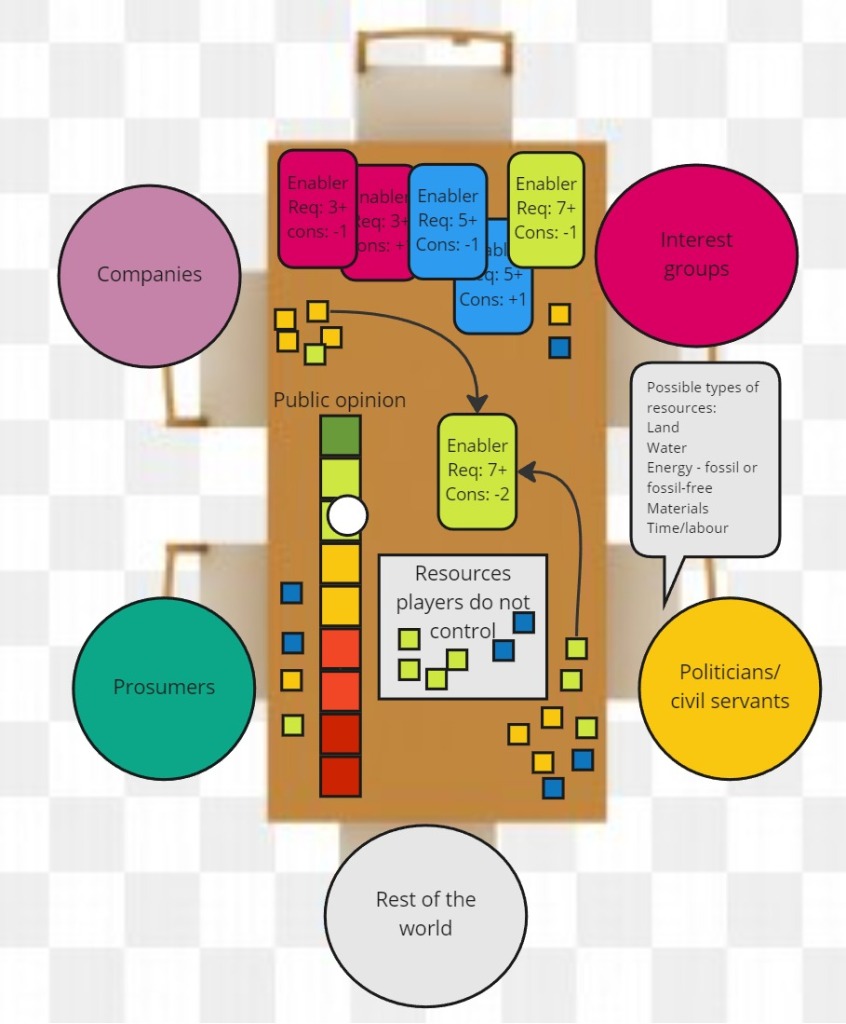The goal for the first part of the journey is to understand the kind of world in which the game will be set. It could easily be assumed that it should be the one we’re all living in – especially as what we’ve set out to do is help people move towards more sustainable consumption patterns – but in fact all games come with a world view of their own (which often happens to coincide with that of the game designer). This involves asking some rather tough questions, such as what kind of view on the future in terms of access to energy, the part played by technology, the role of governments, etc., and so, since my first post in this blog, I’ve done some reading of the publications by the MISTRA Sustainable Consumption research project and also had two long discussions with my colleagues about what this game will ultimately be about. The process of trying to understand the world view that the research my colleagues have been conducting was based on and converting that into game mechanisms has been very rewarding, both in terms of learning more about the game but and as it has allowed me to review my own preconceptions about the world.
One of the main outcomes of this process was that the game will work on the assumption that ‘supply [largely] dictates demand, rather than the other way around’. In short, people in the game will buy the products that the shop owners have in stock (rather than refraining from buying things at all) – however, they may like the choices they are presented with (and ‘forced’ to make) to a higher or lower degree. This aspect is represented by the concept of ‘acceptance’ as used in connection with the 62 ‘enablers’ proposed by the MISTRA research project. As a result, unlike in the Climate Change Megagame, no players will assume the roles of consumers/citizens that react to and may choose to adopt proposed changes based on whether they consider them helpful in achieving their goals in the game, and I will instead experiment with a ‘Public opinion’ track (see illustration) to express how well the population as a whole take to changes implemented by players. This is not at all controversial, as it has been used in similar ways in megagames such as Watch the Skies and Urban Nightmare. However, it means relying on game mechanics designed beforehand to handle the reactions of the public, which may necessitate the use of dice not to turn the whole game into a large-scale exercise in calculating the exact route to the future.

The second team meeting resulted in a sketch (done in Miro during a break to stretch our legs) that we used to discuss the game in more definite terms. This is one step in making the outcome more tangible and in my experience facilitates boiling our ideas down so as to become manageable and also encourages associations to things that have not yet come up during the discussion, the importance of which are such that one later finds it incomprehensible how one could have failed to see it for so long. The rough sketch we made is of a 4-5 player board game in which the players take on different roles (i.e. ideas of what’s important). Players have personal goals and their own resources, but they also have a couple goals in common (keeping the public happy and implementing more sustainable consumption habits) and a number of cards with ‘enablers’ that – if realised by spending the required amount of resources – will potentially take them closer to their goals. The two main conflict surfaces in the game are which enablers should be realised (or in what order) and from where/who the resources required to realise them should come. Progress in the game is tracked in terms of CO2 emissions and result in consequences that alter conditions in the game, e.g. draughts (less food in the world) or trade wars (access to/prices of resources change).
This is game is uncomplicated enough to create – if we disregard the time-consuming science of translating the enablers/CO2 emission-related consequences/etc. into game terms – and can be both played by smaller groups/families and used as a base for the creation of a megagame. As described by Wallman in his excellent four-post guide ‘Megagame Design The Easy Way’ (which I discuss in a post in the Switching the Current game design blog), using an existing board game to create a megagame involves adding teams of players and reducing the complexity of game mechanics to allow a larger number of players to handle them while focusing on interaction between players. However, before going on to this, I’ll put in some more work on the sketch and discuss it with my colleagues in two weeks’ time, so that they can see in which direction we’re going with this and I gain their help with filling in the gaps in terms of content. The fact that there’s already a card game version using the enablers is a great help in this as we’ll be using some of the cards and also be able to draw on the experience of playing that game with different groups of players. The major difference between the existing and new games is that the former does not have the resource part that the latter will have, and so the experience playing the two games will be quite different.
In my next post, I imagine I’ll be reflecting on the process of refining the sketch to create an outline of the game and also share some insights regarding what exposing it to my team members led to in terms of new directions and ideas.
